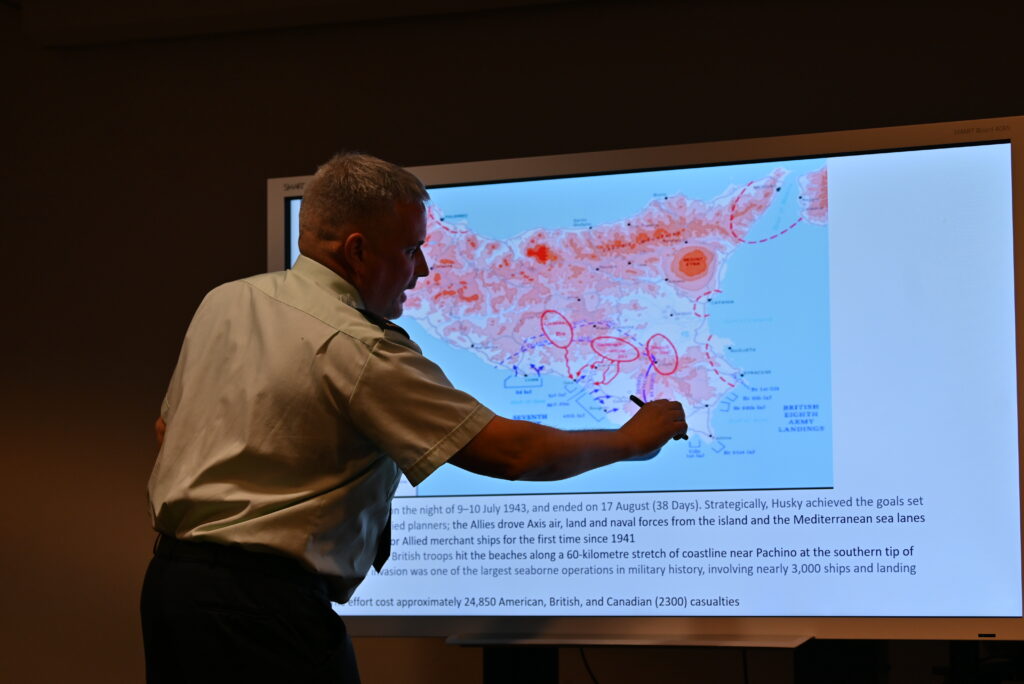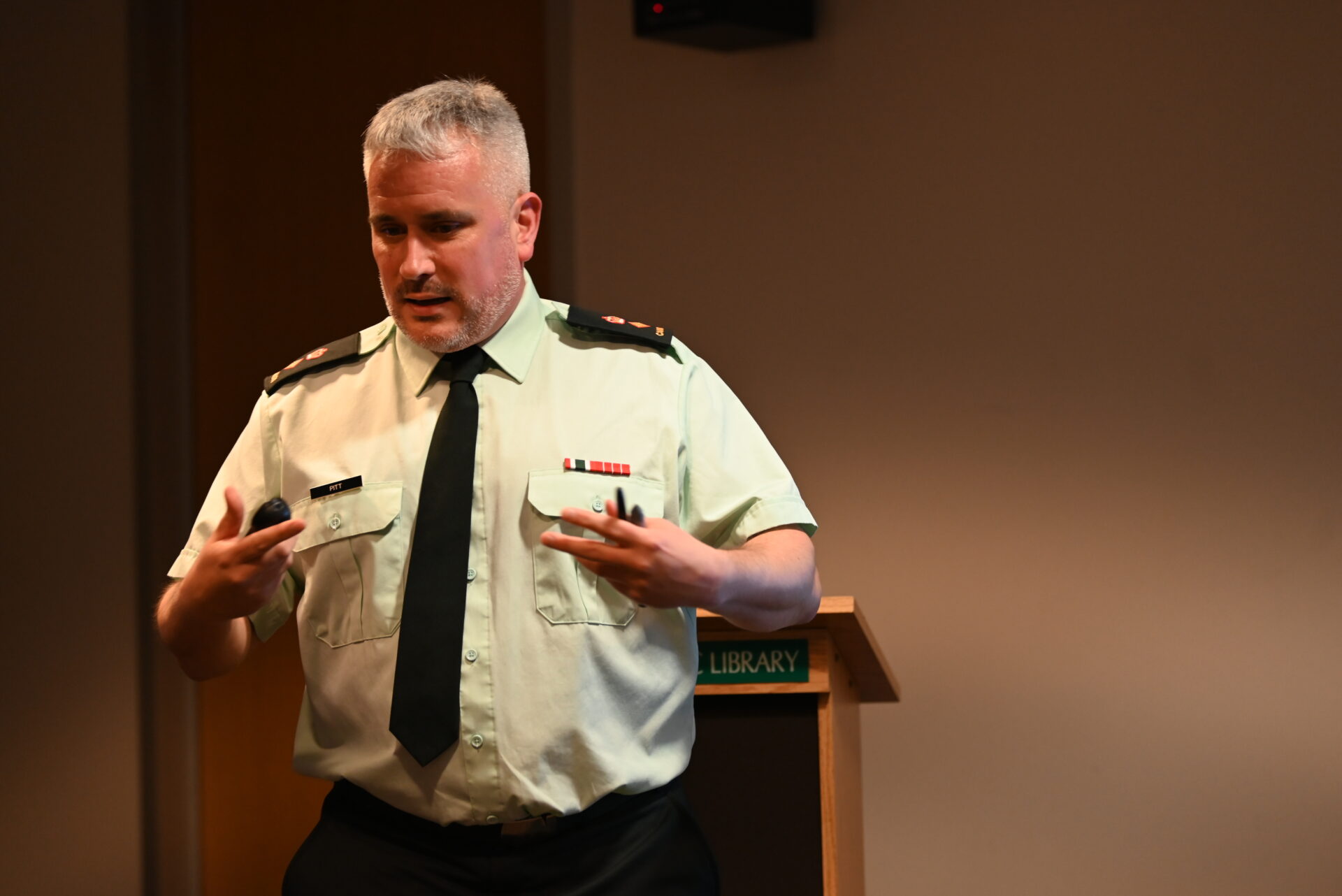Nearly 20 people attended a presentation to commemorate the 80th anniversary of Brantford’s 56th Field Artillery Regiment allied invasion of Sicily at the Brantford Public Library on Wednesday, November 8, 2023.
The 56th Field Artillery Regiment RCA headquarters is located in Brantford and includes the active sub-units of the 54th Field Battery, 10th Field Battery in St. Catharines and 69th Field Battery in Simcoe.
During the hour-long presentation, Lieutenant Colonel Patrick Pitt, Commanding Officer of the 56th Artillery Regiment, who studied the Italian campaign while completing his Masters of Defence studies at Canada’s Royal Military College, spoke to guests about Canada’s, and Brantford’s role within the invasion.
The Allied invasion of Sicily, which is also known as the Battle of Sicily, or Operation HUSKY, was a significant campaign of World War Two.
On July 10, 1943, Allied forces began a six-week campaign to invade the Island of Sicily and take it from Fascist Italy and Nazi Germany powers. The invasion began with a large amphibious assault (a warfare ship employed to land and support ground forces on enemy territory) followed by a land-campaign that ended on August 17, 1943.
“This is important to me because as the Commanding Officer in the 56 Field Regiment, it’s important that I steward the history of the unit and pass it on to the soldiers and leaders,” he said. “What a lot of Canadians and a lot of Brantfordtonians may not be aware of, is the Italian campaign.”
Pitt said that why other battles are memorialized in Hollywood films, the Battle of Sicily is often skipped over or not thought of.
“We have films like Saving Private Ryan, Band of Brothers, and the Longest Day, you know, all of those great films which seem to be hyper focused on the Northwest, the Cross Channel attack, the campaign through France and maybe the Netherlands. But not much attention these days gets paid to the Italian campaign,” he said. “You might hear a bit about the Battle of Ortona or the Battle of Stalingrad, as you should because it’s a big deal, but how many Canadians know anything about Sicily and what kicked it off? How many know that it was the Canadians that broke the Hitler line and not the Americans or the British? It’s important because this isn’t really passed on in our high schools.”

He noted that Brantford has a significant history within the campaign.
“There was a Gunner from Brantford named Harold Schultz of the 1st Field Regiment, Royal Canadian Horse Artillery (RCHA) who was the first Canadian casualty of the Italian Campaign,” said Pitt.
Pitt then went on to discuss how Operation HUSKY came about and the idea behind it.
“The Americans, they want to get across Channel Battle right away, they want to cross right away. The grand allied strategy from Churchill is, ‘we’re not ready, so instead, we’re going to go through the soft underbelly of Europe following the North African campaign. We’re going to cross into Sicily at three points,’” said Pitt. “The Americans were coming up on the west side, and the English coming up on the east. But nobody talks about the Canadians, which is a shame because we went up the centre, and guess where the enemy was at the hardest?”
The purpose of the HUSKY campaign was several fold. One, to draw away some of the German divisions that were at the doors of Moscow, and two, to encourage Italians on the verge of turning against Mussolini and therefore turn an ally of the Germans.
Before the soldiers began the land campaign, they first had to complete the amphibious assault.
“Operation HUSKY was larger and more complex as an amphibious assault than Normandy (D-Day landings). It was an untested ally and yes, there was North Africa, but this was the first time the Canadians had had a chance to get back into the fight since the all the training for Eighth Army which had taken place in Northern Scotland.
He said that the weather was just one of the factors soldiers had to deal with.
“I don’t know if you know your geography, but Italy and Scotland, they are not like each other in terms of weather. You’ve got Canadians who’ve been training in the wet, cold, and yes, some mountainous terrain, and they are training well,” said Pitt. “But to land on the beaches, where the heat in itself is going to be an enemy with sickness, Malaria, and Dysentery.”
They also lost two of the transport ships that were sunk on the way to the beaches near Pachino.
“They lost about half a troop of guns right out of the gate, and they were constantly harassed by U boats hooking down from the North and from the West.”
Not only were they dealing with a shortage of weapons and the weather, but aerial attacks made unloading equipment difficult.
As the soldiers eventually moved inland, the mountain top towns were held by German troops and travel was rough as many of the roads were damaged from aerial attacks.
The the soldiers made their way to Mount Assoro, where the German enemies were stationed on the West side, they had to deal with the enemy having a birds-eye view of the soldiers and could pick them off from above.
“Terrain is an issue and there’s very narrow grounds, so you can’t attack on a wide front,” said Pitt. “And if you’re the Germans or Italians looking South, you can really see what’s coming in the distance.”
Though, Canadians of the Hastings and Prince Edward Regiment (Hasty Ps) managed to scale the east side of the mountain and surprised the Germans the next morning from above.
Operation Husky continued to move forward towards Mount Etna, taking Leonforte, Agira, Nissoria, Regalbuto.
On August 7 the Canadian Division camped at the foot of Mount Etna and went into reserve. Ten days later, on August 17, the day was marked as the finals victory in Sicily.
After talking about Operation HUSKY, Pitt went on to speak about the 56 Artillery Regiment’s recent trip to Sicily in July of this year.
Several members went on to complete the same route their fallen brothers had taken in 1943, and stopped to lay memorial wreaths on the graves of those who fell during Operation HUSKY.
Kimberly De Jong’s reporting is funded by the Canadian government through its Local Journalism Initiative.The funding allows her to report rural and agricultural stories from Blandford-Blenheim and Brant County. Reach her at kimberly.dejong@brantbeacon.ca.
